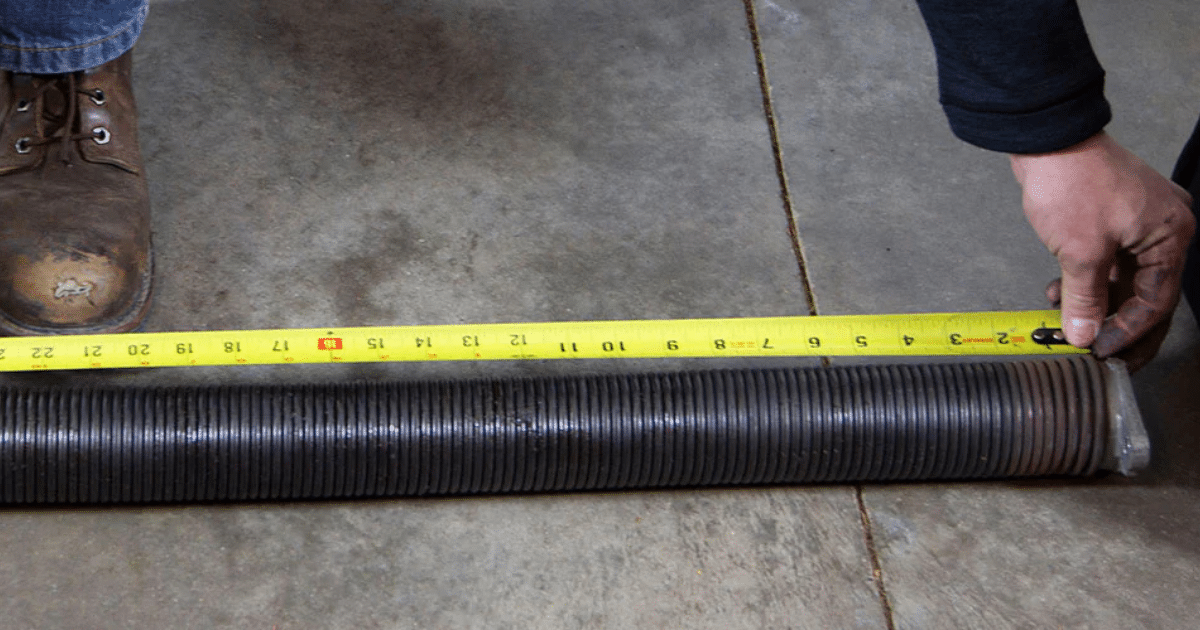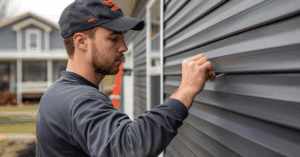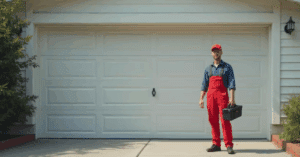Understanding how your garage door works starts with knowing how spring tension affects its movement. One of the best tools for this is the garage door spring tension chart. This chart shows the correct tension levels your door needs to open and close smoothly. Knowing this can help prevent damage, avoid safety risks, and reduce future repair costs.

Garage door springs support the entire weight of the door, and even small mistakes in tension can lead to bigger problems. This comprehensive guide explains everything you need to know about the garage door spring tension chart, enabling you to maintain your door properly. You will also learn when it’s time to call a trusted professional for help.
Importance of Spring Tension in Garage Doors
The spring tension in garage doors matters more than most people realize. It controls how easily and safely your door opens and closes. With the help of a garage door spring tension chart, you can ensure the springs are properly balanced to avoid strain and damage.
Wrong tension can cause real problems. If springs are too tight, the door feels heavy. If they are too loose, the door won’t stay up. These spring adjustment issues are not just frustrating but also dangerous, especially if you have kids or pets around the garage.
Getting the tension right keeps your whole system running longer. Taking care of your garage door helps you avoid costly garage door repairs and save money. When the springs stay balanced, you also protect the opener, cables, and other parts. This is why it’s important to check the spring tension often.
Overview of the Garage Door Spring Tension Chart
The garage door spring tension chart is a handy guide that shows the required tension for various door weights and spring types. It lists door size, weight, and matching spring specs. This chart helps make sure your springs are the right fit for smooth, safe movement.
By using the chart, homeowners can match their door’s weight and size with the correct spring type. This prevents common problems like choosing springs that are too tight or too loose. The right spring size helps keep the door balanced and protects other garage door parts from damage.
The chart is also helpful for fixing spring tension problems. If your door feels off or moves unevenly, compare its actual tension with the chart’s recommendations. This can help determine if your springs are causing the issue, allowing you to address it before the problem worsens.
How to Read the Garage Door Spring Tension Chart
Reading the garage door spring tension chart requires a basic understanding of its components. The chart is usually divided into sections that list door weights, spring types, and the corresponding tension requirements. Here’s a step-by-step guide to help you interpret the chart effectively:
1. Identify Your Door Weight
The first step is to determine the weight of your garage door. This information is critical as the tension required is directly related to the door’s weight.
2. Locate the Correct Spring Type
The chart will have sections for different types of springs, including torsion and extension springs. Ensure you are looking at the section that corresponds to the springs used in your garage door system.
3. Match Your Door Weight with Tension Requirements
Once you have identified the appropriate section, find the row that corresponds to your door weight. This will provide you with the tension specifications required for optimal performance.
By understanding how to read the chart, homeowners can ensure their garage doors are equipped with the right springs, reducing the risk of operational issues and enhancing safety.
Factors Affecting Garage Door Spring Tension
Several factors can influence the tension of your garage door springs. Knowing these factors helps keep the spring tension right and supports your garage door system lasting longer. Here are some key factors to consider:
Door Weight Changes
Any alterations to the door, such as adding insulation or replacing panels, can change its weight, affecting spring tension requirements.
Spring Wear and Tear
As time passes, springs may weaken or stretch, causing changes in their tension. Regular inspections can help detect these changes early.
Temperature Fluctuations
Very hot or cold weather can affect the tension in your garage door springs. Cold weather can make springs brittle, while heat can cause them to expand.
By being aware of these factors, homeowners can take proactive steps to adjust spring tension as needed, ensuring their garage door continues to operate smoothly.
Common Issues Related to Spring Tension

Misaligned or incorrect spring tension can lead to various garage door issues. These are a few issues that homeowners often face:
- Door Doesn’t Open or Close Completely: This issue often indicates that the spring tension is too loose or too tight, preventing the door from moving smoothly along its tracks.
- Uneven Door Movement: If one side of the door moves faster than the other, it could be due to uneven tension in the springs, which can cause the door to become misaligned.
- Excessive Noise: Loud noises during operation might suggest that the springs are under too much tension, causing them to strain and potentially damage other parts of the door system.
Understanding these issues can help homeowners diagnose problems quickly and take corrective action, whether through adjustments or by consulting a professional.
Adjusting Garage Door Spring Tension Safely
Changing the tension on garage door springs requires careful attention, as even slight mistakes can lead to problems or safety risks. Here are some safety tips and steps for adjusting spring tension:
1. Gather Necessary Tools
Before beginning, ensure you have the appropriate tools, such as winding bars for torsion springs or a ladder for better reach.
2. Follow Precise Steps
For torsion springs, use winding bars to adjust the tension, turning the spring in small increments. For extension springs, change the hook to increase or decrease tension.
3. Test the Door
Once you finish the adjustments, check if the door opens and closes properly. If it still feels off, make small changes until the balance feels right.
Always put safety first when working on garage door spring adjustments. If you’re unsure about the process, it’s best to consult a garage door repair professional to avoid injury.
When to Seek Professional Help
Some garage door repairs are simple, but dealing with spring tension is risky and should be done by a professional. If the garage door spring tension chart does not solve the issue or your door still moves unevenly, it’s time to call a skilled technician for safe and proper adjustments.
Broken springs are hazardous and require specialized tools for replacement. Attempting to fix it yourself can cause injuries or exacerbate the problem. A professional knows how to safely release spring tension and install the correct type of spring. This is the best way to keep your garage door running safely and smoothly.
If your door keeps jamming, shaking, or won’t stay open, there may be a hidden issue. Frequent problems like this are signs that you may need expert garage door repair. A pro can inspect the entire system, fix it fast, and prevent bigger problems later.
Maintenance Tips for Garage Door Springs
Taking care of your garage door springs regularly helps them last longer and avoid sudden problems. Try these simple maintenance tips to keep your springs working properly:
1. Lubricate Regularly
Apply lubricant to your garage door springs every few months to keep them functioning smoothly. This helps reduce friction, prevents rust buildup, and keeps the springs moving smoothly and quietly over time.
2. Inspect Frequently
Look over your garage door springs for any rust, damage, or signs of wear. Looking often helps you spot small issues early, so you can fix them before they worsen.
3. Balance Check
To test if your garage door is balanced, unplug the opener and manually lift the door to the halfway point. If it stays in place, spring tension is correct. If not, it needs adjustment.
By incorporating these maintenance practices, homeowners can enhance the performance and longevity of their garage door springs.
FAQs About Garage Door Spring Tension Chart
How do I know the correct tension for my garage door spring?
To find the correct tension, use a garage door spring tension chart that matches your door’s weight and size. The chart illustrates the number of turns required. If the spring feels too tight or loose, it may need adjustment.
What does IPPT stand for in a garage door spring tension chart?
IPPT stands for Inch-Pounds Per Turn. It indicates the amount of force the spring provides with each full turn. A garage door spring tension chart utilizes IPPT to match the spring strength with your garage door’s weight, ensuring smooth operation.
How do I calculate garage door spring tension?
You need to know your garage door’s weight and the spring’s IPPT rating. Use a garage door spring tension chart to determine the number of turns required. This keeps the door balanced and prevents damage to the opener or track.
What’s the easiest way to figure out garage door spring size?
Measure your current spring’s length, inside diameter, and wire thickness. Then use a garage door spring tension chart to find the matching size. This helps you pick the right replacement and avoid putting the wrong tension on the door.
What should I do if the spring tension chart doesn’t match the weight of my garage door?
If the garage door spring tension chart does not match your door’s weight, check your measurements again. Weigh your garage door if needed. The wrong spring can cause harm to your garage door system. Ask a pro if you are unsure.
Conclusion
If your garage door feels off-balance or won’t open smoothly, it may be time to check the spring tension. Using a garage door spring tension chart helps you spot issues early and keep your system running safely. Don’t ignore the signs of a faulty spring.
For homeowners seeking trusted assistance, our team at New Braunfels Garage Door Repair is here to make things easy. We offer fast, honest, and affordable garage door repair in New Braunfels, TX, whether you need spring adjustments or full replacements. We’re here to make sure your garage door works smoothly again.
Address small issues promptly to prevent costly repairs later. If you’re unsure about using a garage door spring tension chart or your door still won’t work right, give us a call. Let New Braunfels Garage Door Repair handle the hard work for you.
End Note
If your garage door isn’t working the way it should, let the trusted team at New Braunfels Garage Door Repair help. From spring replacement to complete installations, we handle everything with care and skill. Visit our leading site at newbraunfelsgarage.com or explore our comprehensive list of garage door services to discover how we can assist you.
Need quick and reliable help? Whether you need garage door repair in New Braunfels, garage door installation, new openers, or broken spring replacement, we’ve got you covered. We also offer top brands like LiftMaster and trusted CHI garage doors for your home.
Explore our comprehensive range of garage doors, opener options, and locations to find out if we serve your area. Want to know more about us? Check out our About Us page, photo gallery, or read our blog for helpful tips. For updates and offers, follow us on Facebook. Ready to get started? Contact us today and let’s get your garage door running like new.





